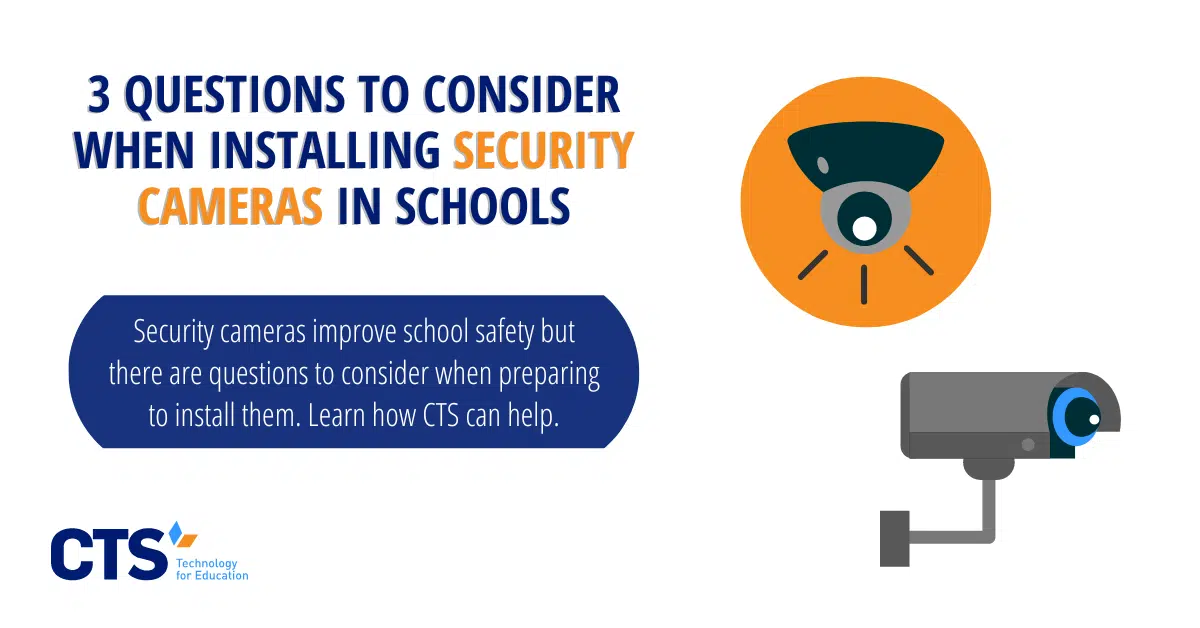Security cameras are an essential part of a facility’s security protocols.
With critical incidents in schools making frequent news headlines, the topic of school safety is top of mind for school leaders. School administrators are often thinking of ways to improve their school’s security protocols and keep their school safety plans up to date.
Ensuring that schools have strong access control systems (like buzzer entry systems, key fobs, visitor management software, etc.) is an important part of a comprehensive safety strategy. A buzzer entry system, most often comprised of an intercom and a camera, can be a school’s first line of defense. This system gives a school the opportunity to visually verify a visitor’s identity and the purpose of their visit before allowing them into the building. A school’s entryway is a great place for a camera and there are many other locations, throughout a school, where additional cameras would increase school safety and security.
Security cameras, dispersed throughout the facility, allow schools to take a more proactive approach to safety.
Strategically placed security cameras can give a school’s leadership team access to real-time information that can be used to keep students and staff safe in the event of an emergency. Because of these benefits, almost 80% of public schools across the nation have security cameras. In addition to providing improved access control and better visitor management, research shows that cameras deter potential external threats. A study conducted by The University of North Carolina shows that half of the burglars surveyed reported that they would flee an area after discovering cameras or other surveillance equipment.
Given this, the question of if a school should integrate security cameras feels easy to answer: the answer is yes. After deciding to install cameras, schools have other decisions to make that will impact their hardware and software choices.
First: Where are the best locations for the cameras?
Camera placement decisions are quite important. There are a few cautionary tales of schools being successfully sued for placing cameras in locations that violated a student’s right to privacy under the Fourth Amendment. School security cameras are to be placed in areas that don’t infringe upon students’ and staff’s right to privacy. Areas like hallways, common areas, and building perimeters – where the expectation of privacy is low – are good places for cameras. Semi-private areas like restrooms and locker rooms are not.
Once the location for each camera has been determined, the next step is to decide on the camera angles. What placement will give the school the best visibility in a particular area? What footage would be most helpful in keeping a building safe and secure? The answers to these questions have key implications for camera procurement and installation.
Next: Who should have access to the video footage?
In order to protect the footage from unauthorized access, loss, or misuse, it’s helpful for schools to proactively set an access policy. Most often the access list includes members of the school leadership and operations teams. After deciding who should have access, restricting access from other parties can be done via physical controls (like locked doors) or electronic controls (like password protection of the monitoring systems). Schools can also choose solutions that give designated users access to camera feeds at any hour on any device.
Finally: How will the footage be stored?
There isn’t necessarily a standard answer for how long schools store security camera footage. Some schools store footage for 30-60 days. Other schools hold on to footage for a bit longer. Whatever a school decides about the length of storage will have key implications for how much storage capacity a school needs access to.
There are many other operational, cultural, and policy questions for schools to consider when integrating security cameras. These include questions about how the school will notify staff, parents, students, and the broader community of the cameras (e.g., posted notices and signage throughout the building or the inclusion of this policy in staff and student handbooks). Answers to other questions about how to handle requests for footage (e.g. requests from parents, members of the community, or external parties like the press) will also influence a school’s security camera policies. These questions related to the impact on the school community are helpful for school leaders to focus on. CTS provides schools with support in answering the questions about location, access, and storage so schools can focus on the implications for their community.
At CTS, we support schools with the technology they need to enhance their safety procedures.
Our team has worked with more than 60 schools across the United States to integrate technology in ways that improve school safety and positively impact student achievement. Comprised of educational technology veterans and former school operations leaders, our team has the technical know-how and on-the-ground experience to support schools as they make decisions about devices, locations, and storage when integrating security cameras. Contact us today to learn more about our services and how we can help your school accomplish its unique mission.




